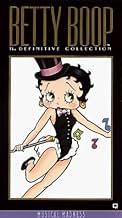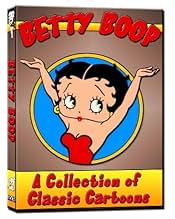Ajouter une intrigue dans votre langueIn her only color cartoon, Betty Boop goes to the ball thanks to her fairy godmother; later, only her foot fits the glass slipper.In her only color cartoon, Betty Boop goes to the ball thanks to her fairy godmother; later, only her foot fits the glass slipper.In her only color cartoon, Betty Boop goes to the ball thanks to her fairy godmother; later, only her foot fits the glass slipper.
- Réalisation
- Scénario
- Casting principal
Jack Mercer
- Various
- (voix)
- (non crédité)
William Pennell
- Pumpkin
- (non crédité)
Bonnie Poe
- Betty Boop
- (voix)
- (non crédité)
- …
Avis à la une
10Popeye-8
Before moving on to their prolific (and highly successful) POPEYE series (as well as into their unfortunate GABBY series--just imagine Elmer Fudd without his macho sex appeal), Paramount's Fleischer brothers poured their creative genius into BETTY BOOP. This is their finest B-B cartoon, and may just be their finest EVER, period.
Using their 3-D filming process (and a unheard-of budget for a cartoon short), they adapted the Cinderella legend to Betty, adding some marvelous songs and (likely roto-scoped) beautiful dance numbers. For reasons not told, this was the only Betty Boop cartoon ever done in color--a tragedy.
Look for versions with the original opening titles intact--even the titles show that this was a project of love (and yes, money). Plus, Betty's as sexy an ingenue as ever thanks to Technicolor.
Using their 3-D filming process (and a unheard-of budget for a cartoon short), they adapted the Cinderella legend to Betty, adding some marvelous songs and (likely roto-scoped) beautiful dance numbers. For reasons not told, this was the only Betty Boop cartoon ever done in color--a tragedy.
Look for versions with the original opening titles intact--even the titles show that this was a project of love (and yes, money). Plus, Betty's as sexy an ingenue as ever thanks to Technicolor.
Long before Rodgers and Hammerstein had the idea of musicalizing Cinderella, Betty Boop made the midnight pumpkin change tunefully, with verve, sex and good story editing. The plot is trimmed to its essentials, the splendid backgrounds may have influenced the Disney Beauty and the Beast, and the closing shot of the Pinocchio-nosed sisters wraps everything up with a laugh.
Poor Cinderella (1934)
**** (out of 4)
Excellent Betty Boop cartoon is the only one to feature her in color and they made her a red head as well! In the film she plays Cinderella who is granted a magical night thanks to her fairy godmother and soon the Prince falls in love with her. Storywise this here is pretty familiar to all the other versions out there but the real interest here is getting to see Betty Boop in color. I'm not sure of the reasonings behind making her a red head but it's certainly interesting to say the very least. The short really does follow the story pretty closely so those expecting to see something new might be disappointed. However, fans of Boop are going to love seeing the sexy "actress" getting to play her looks down as the abused Cinderella. I thought these early scenes were very good and things certainly got better as the Pre-Code naughty moments happen and this is when Betty is pretty much stripped down in order for her new clothes to be put on her. Modern audiences probably wouldn't even think about this but film buffs know this wasn't always accepted. The Technicolor is also extremely good here and overall this is just a highly entertaining short.
**** (out of 4)
Excellent Betty Boop cartoon is the only one to feature her in color and they made her a red head as well! In the film she plays Cinderella who is granted a magical night thanks to her fairy godmother and soon the Prince falls in love with her. Storywise this here is pretty familiar to all the other versions out there but the real interest here is getting to see Betty Boop in color. I'm not sure of the reasonings behind making her a red head but it's certainly interesting to say the very least. The short really does follow the story pretty closely so those expecting to see something new might be disappointed. However, fans of Boop are going to love seeing the sexy "actress" getting to play her looks down as the abused Cinderella. I thought these early scenes were very good and things certainly got better as the Pre-Code naughty moments happen and this is when Betty is pretty much stripped down in order for her new clothes to be put on her. Modern audiences probably wouldn't even think about this but film buffs know this wasn't always accepted. The Technicolor is also extremely good here and overall this is just a highly entertaining short.
Max & Dave Fleischer & co. were among the very best of the creators of novel and surprising applications of animation from the late teens through the entire decade of the 1930's. For "Poor Cinderella", they must have noted Disney's stunning "Flowers And Trees", produced in 1931 and released the following year. The latter is generally credited as being the first full color process American cartoon, as opposed to two strip color which emphasized either blues or greens at the expense of certain shades that were lost to the lesser and less costly techniques of the day. For budgetary reasons, the ever inventive Fleischer Bros. developed their own "Cinecolor" approach, which was a variant on the two-strip color format. Although it apparently never quite caught on, they had applied for a patent while releasing their astoundingly beautiful and hysterically surreal and laugh-laden Boop masterpiece in 1934, the only Betty Boop color cartoon.
Combining their proprietary Rotoscope technique along with other dimension enhancing toolkit tricks, few cartoon shorts have ever matched this effort for sheer entertainment value. They did try saving money on the color, as mentioned, but the whole production was obviously a very expensive endeavor, when all its components are considered in sum. The results offer a lasting tribute to the art and magic of 1930's animation.
As a Depression-era vehicle, good jobs were scarce but the Fleischer team's uproarious talent sported young and brash animators who were willing to push the envelope of sensibilities and censors alike, much to our delight. Even the closing sequence is incredibly absurd, and gems like this will forever prevail.
Betty had already helped launch the Popeye series a year earlier, so by 1934 the Fleischers had their distinctly urban stamp firmly planted under two cartoon banners aimed as much, if not more, at adults as the kids. If that weren't true, they wouldn't have always had to play "duck and cover" with the ever-present Hays commission, censor gavel at the ready. Thanks to the Fleischer folks and all involved parties, for the guts, the creative ambition, the sheer genius, and the uncompromising quality of whichever production standards were chosen to collectively coalesce into a cartoon gem for the ages. This is a must see.
Combining their proprietary Rotoscope technique along with other dimension enhancing toolkit tricks, few cartoon shorts have ever matched this effort for sheer entertainment value. They did try saving money on the color, as mentioned, but the whole production was obviously a very expensive endeavor, when all its components are considered in sum. The results offer a lasting tribute to the art and magic of 1930's animation.
As a Depression-era vehicle, good jobs were scarce but the Fleischer team's uproarious talent sported young and brash animators who were willing to push the envelope of sensibilities and censors alike, much to our delight. Even the closing sequence is incredibly absurd, and gems like this will forever prevail.
Betty had already helped launch the Popeye series a year earlier, so by 1934 the Fleischers had their distinctly urban stamp firmly planted under two cartoon banners aimed as much, if not more, at adults as the kids. If that weren't true, they wouldn't have always had to play "duck and cover" with the ever-present Hays commission, censor gavel at the ready. Thanks to the Fleischer folks and all involved parties, for the guts, the creative ambition, the sheer genius, and the uncompromising quality of whichever production standards were chosen to collectively coalesce into a cartoon gem for the ages. This is a must see.
Betty Boop as Cinderella. an idea who seems strange but this short animation is the ideal proof for define it as inspired. because all is nice - the songs, the dance, the short story preserving essence of fairy tale and the colors, the technique and the ingenuity of Betty. at first, naive, it is the perfect illustration of significant episode of animation history.
Le saviez-vous
- AnecdotesRather than making animated backgrounds using drawings the Fleischers pioneered the idea of using either models or cutouts mounted on a turntable. The table was slowly spun and photographed. The foreground animation was then placed in front of the photographed backgrounds. This not only saved hundred of hours of drawing but also lent a 3D effect to the back ground. It was used here and in numerous "Popeye" cartoons.
- Versions alternativesOne 1980s VHS release of "Poor Cinderella" has the entire color cartoon presented in black-and-white.
- ConnexionsEdited into Betty Boop Confidential (1995)
- Bandes originalesPoor Cinderella
Written by Charles Tobias, Murray Mencher, Jack Scholl
Sung by Betty Boop
Performed by Phil Spitalny and his orchestra
Later sung by Betty and by the singer with the megaphone
Meilleurs choix
Connectez-vous pour évaluer et suivre la liste de favoris afin de recevoir des recommandations personnalisées
Détails
- Durée11 minutes
- Rapport de forme
- 1.37 : 1
Contribuer à cette page
Suggérer une modification ou ajouter du contenu manquant

Lacune principale
By what name was Poor Cinderella (1934) officially released in Canada in English?
Répondre
















